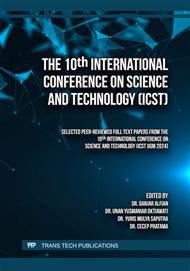p.765
p.771
p.783
p.796
p.802
p.814
p.825
p.845
p.854
The Road Condition Classification Using Machine Learning Method Based on Vibration Measurement Data in Yogyakarta
Abstract:
Transportation is one of the crucial factors in the development of a country. This can be observed from the increasing needs of transportation in supporting human activities in residential and urban areas. Therefore, it is essential to maintain the infrastructure that supports the needs of transportation. One of the infrastructures that need to be considered as the main factor of transportation is road condition. Damaged road conditions can cause obstacles to the transportation system. One way to detect road damage is by measuring the vibration values that occur under different road conditions using an accelerometer as a vibration recorder. The vibration data is classified into three groups based on the road conditions where the recordings took place, namely good road condition, speed bumps (bump), and potholes. A total of 52 data samples were collected for each road condition in Yogyakarta using a motorcycle, which were then processed into vibration data in the frequency domain. The vibration data processing was carried out using Jupyter Notebook software with Python programming language and the algorithms used in this research were Fast Fourier Transform (FFT), SG Filtering, and Power Spectral Density (PSD) to determine the strength of the vibration signal. After that classification was performed by applying supervised machine learning using the multiclass classification algorithm on Support Vector Machine (SVM) other than that, cross-validation process was implemented to know the performance of the machine learning model. The classification results show an accuracy value of 92.31% for predicting road condition labels in the training model and 97.44% for the testing model. Both models are calculated using 75% of the total data for the training model and 25% of the total data for the testing model.
Info:
Periodical:
Pages:
802-813
Citation:
Online since:
October 2025
Keywords:
Price:
Сopyright:
© 2025 Trans Tech Publications Ltd. All Rights Reserved
Share:
Citation:


